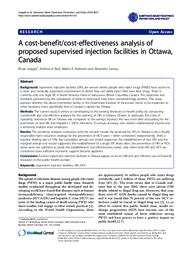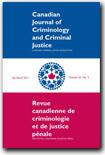Jozaghi, Ehsan
Person Preferred Name
Ehsan Jozaghi
Related Works
Content type
Digital Document
Abstract
Background:
This paper will determine whether expanding Insite (North America’s first and only supervised injection facility) to more locations in Canada such as Montreal, cost less than the health care consequences of not having such expanded programs for injection drug users.
<p>Methods:
By analyzing secondary data gathered in 2012, this paper relies on mathematical models to estimate the number of new HIV and Hepatitis C (HCV) infections prevented as a result of additional SIF locations in Montreal.
<p>Results:
With very conservative estimates, it is predicted that the addition of each supervised injection facility (up-to a maximum of three) in Montreal will on average prevent 11 cases of HIV and 65 cases of HCV each year. As a result, there is a net cost saving of CDN$0.686 million (HIV) and CDN$0.8 million (HCV) for each additional supervised injection site each year. This translates into a net average benefit-cost ratio of 1.21: 1 for both HIV and HCV.
<p>Conclusions:
Funding supervised injection facilities in Montreal appears to be an efficient and effective use of financial resources in the public health domain.
Origin Information
Content type
Digital Document
Abstract
Background: Supervised injection facilities (SIFs) are venues where people who inject drugs (PWID) have access to a clean and medically supervised environment in which they can safely inject their own illicit drugs. There is currently only one legal SIF in North America: Insite in Vancouver, British Columbia, Canada. The responses and feedback generated by the evaluations of Insite in Vancouver have been overwhelmingly positive. This study assesses whether the above mentioned facility in the Downtown Eastside of Vancouver needs to be expanded to other locations, more specifically that of Canada’s capital city, Ottawa.
<p>Methods: The current study is aimed at contributing to the existing literature on health policy by conducting cost-benefit and cost-effective analyses for the opening of SIFs in Ottawa, Ontario. In particular, the costs of operating numerous SIFs in Ottawa was compared to the savings incurred; this was done after accounting for the prevention of new HIV and Hepatitis C (HCV) infections. To ensure accuracy, two distinct mathematical models and a sensitivity analysis were employed.
<p>Results: The sensitivity analyses conducted with the models reveals the potential for SIFs in Ottawa to be a fiscally responsible harm reduction strategy for the prevention of HCV cases – when considered independently. With a baseline sharing rate of 19%, the cumulative annual cost model supported the establishment of two SIFs and the marginal annual cost model supported the establishment of a single SIF. More often, the prevention of HIV or HCV alone were not sufficient to justify the establishment cost-effectiveness; rather, only when both HIV and HCV are considered does sufficient economic support became apparent.
<p>Conclusions: Funded supervised injection facilities in Ottawa appear to be an efficient and effective use of financial resources in the public health domain.
Origin Information
Content type
Digital Document
Abstract
This study was conducted not only to explore how peers intervene to shape social networks but to capture the transformative role of peer-led intervention by local needle exchange programs and a supervised injection facility in Vancouver, Canada. Semi-structured qualitative interviews were conducted with peer volunteers as they were involved in their routine work activities. Interviews were analysed thematically using two methods of coding analysis. Findings suggest that peers were taking on important education and safety roles and were able to alter the behaviour, attitude, and intention of injection drug users within the Downtown Eastside area of the city. Further, peer injection drug users were able to reach individuals who were reluctant to seek medical help, housing, or prevention services. Peers serve as an agent of change in the Downtown Eastside to disseminate information and riskreduction skills to the most marginalized people.
Origin Information
Content type
Digital Document
Abstract
Supervised injection facilities (SIFs) or supervised consumption rooms are a component of harm reduction strategies that attempt to reduce drug overdoses and risky injection behaviors among injection drug users. The purpose of this study is to determine whether expanding SIFs into the City of Toronto, Ontario, would be a fiscally responsible decision. By analyzing secondary data gathered in 2013, this article relies on mathematical models to estimate the number of new HIV and hepatitis C virus infections prevented as a result of SIF locations in Toronto. After factoring in the costs associated with SIFs, the models produce cost–benefit and cost-effectiveness outputs. With very conservative estimates, it is predicted that establishing SIF locations in Toronto is cost effective with an average benefit–cost ratio of 1:1.2 for the first two facilities based on the sensitivity analysis at 30% sharing rate. Consequently, funding SIFs in Canada’s largest city appears to be an efficient and effective use of financial resources in the public health domain with cost savings in excess of CAN$728,620 per year for the first two facilities.
Origin Information




